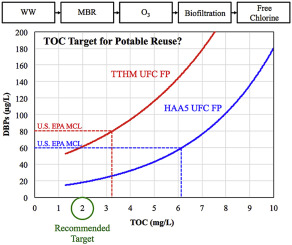Chemosphere ( IF 8.8 ) Pub Date : 2018-03-13 , DOI: 10.1016/j.chemosphere.2018.03.085 Mayara Arnold , Jacimaria Batista , Eric Dickenson , Daniel Gerrity

|
The purpose of this research was to investigate the impacts of ozone dose and empty bed contact time (EBCT) in ozone-biofiltration systems on disinfection byproduct (DBP) formation potential. The data were used to evaluate the possibility of using DBP formation potential as an alternative guideline for total organic carbon (TOC) removal in potable reuse applications. A pilot-scale ozone-biofiltration system was operated with O3/TOC ratios ranging from 0.1 to 2.25 and EBCTs ranging from 2 to 20 min. The biofiltration columns contained anthracite or biological activated carbon (BAC). Bench-scale chlorination was performed using the uniform formation conditions (UFC) approach, and quenched samples were analyzed for total trihalomethanes (TTHMs) and regulated haloacetic acids (HAA5s). The data demonstrated that ozone-biofiltration achieved TOC removals ranging from ∼10 to 30%, depending on operational conditions, but biofiltration without ozone generally achieved <10% TOC removal. UFC testing demonstrated that ozone alone was efficient in transforming bulk organic matter and reducing DBP formation by 10–30%. The synergistic combination of ozone and biofiltration achieved average overall reductions in TTHM and HAA5 formation potential of 26% and 51%, respectively. Finally, a maximum TOC concentration of 2.0 mg/L was identified as a recommended treatment target for reliable compliance with TTHM and HAA5 regulations for potable reuse systems in the United States.
中文翻译:

臭氧生物过滤技术在饮用水回用应用中用于大量有机物去除和副产物消毒的缓解
这项研究的目的是研究臭氧生物滤池系统中臭氧剂量和空床接触时间(EBCT)对消毒副产物(DBP)形成潜力的影响。数据用于评估使用DBP形成潜力作为在饮用水回用应用中去除总有机碳(TOC)的替代指南的可能性。使用O 3运行中试规模的臭氧生物过滤系统/ TOC比率范围从0.1到2.25,EBCT范围从2到20分钟。生物过滤柱包含无烟煤或生物活性炭(BAC)。使用均一形成条件(UFC)方法进行台式规模的氯化,并分析淬灭后的样品中的总三卤甲烷(TTHMs)和调节的卤乙酸(HAA5s)。数据表明,根据操作条件的不同,臭氧生物滤池的TOC去除率约为10%至30%,但不含臭氧的生物滤池的TOC去除率通常<10%。UFC测试表明,仅臭氧就能有效转化大量有机物并将DBP形成减少10–30%。臭氧和生物过滤的协同作用使TTHM和HAA5的形成潜力平均平均降低了26%和51%。最后,



























 京公网安备 11010802027423号
京公网安备 11010802027423号